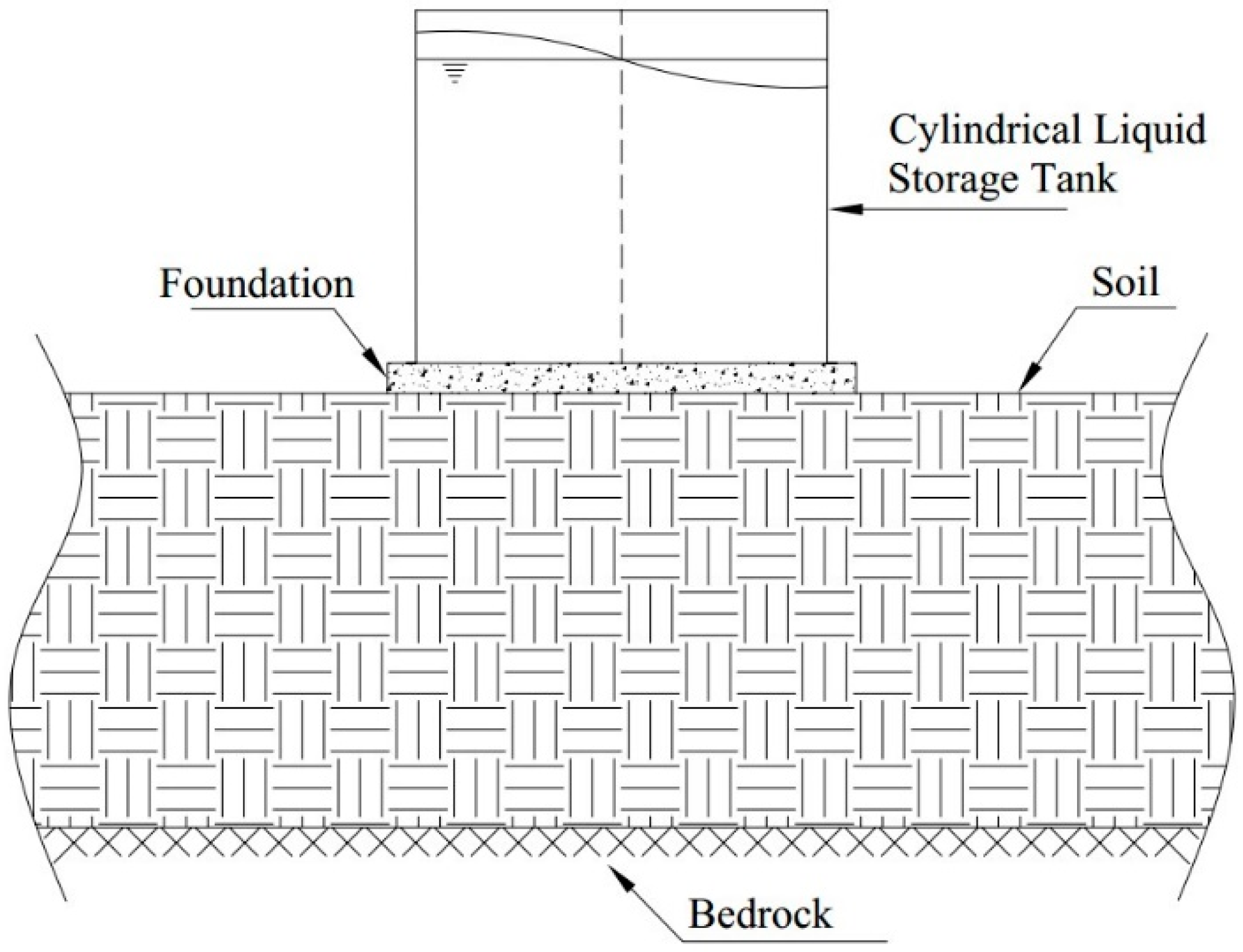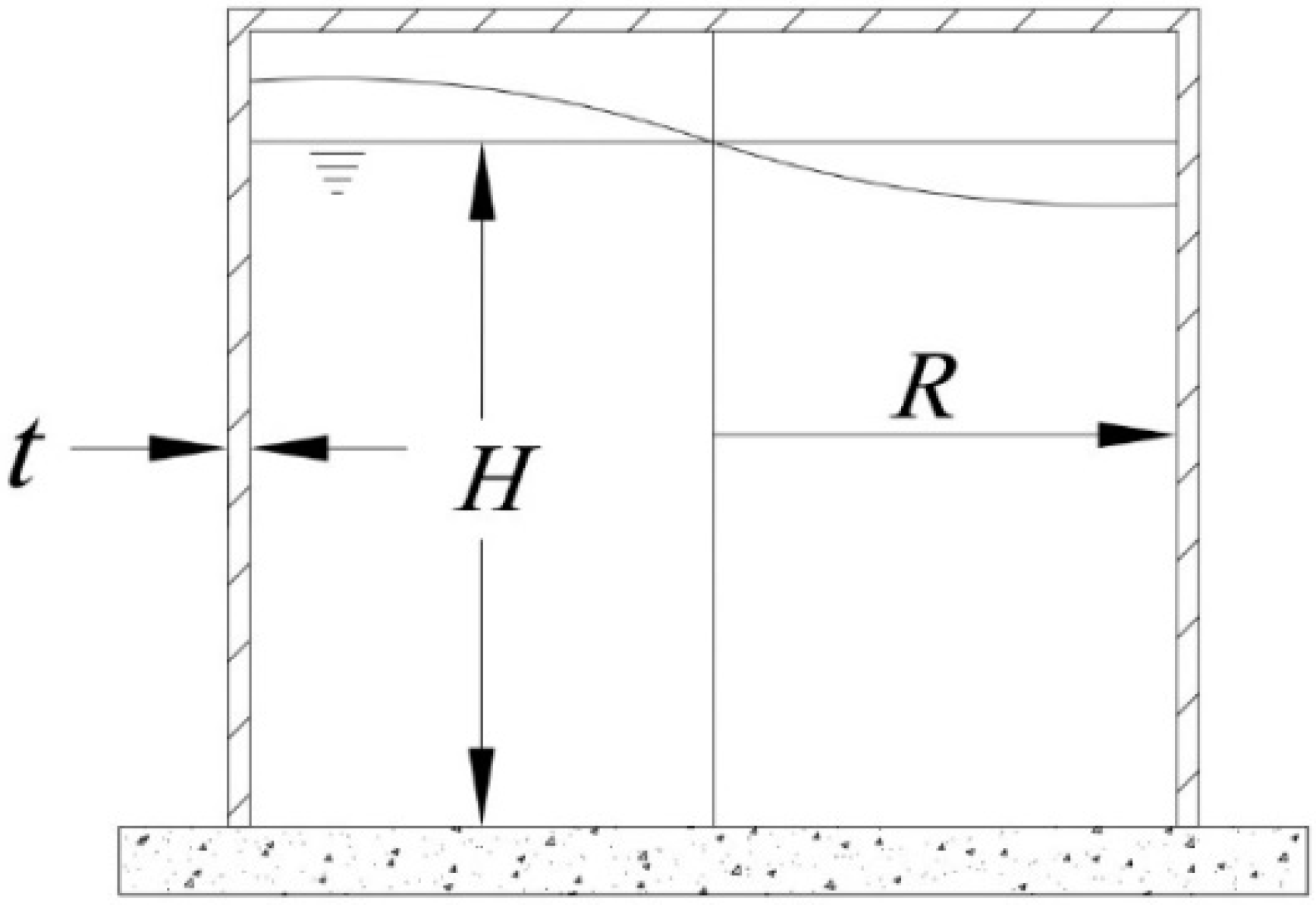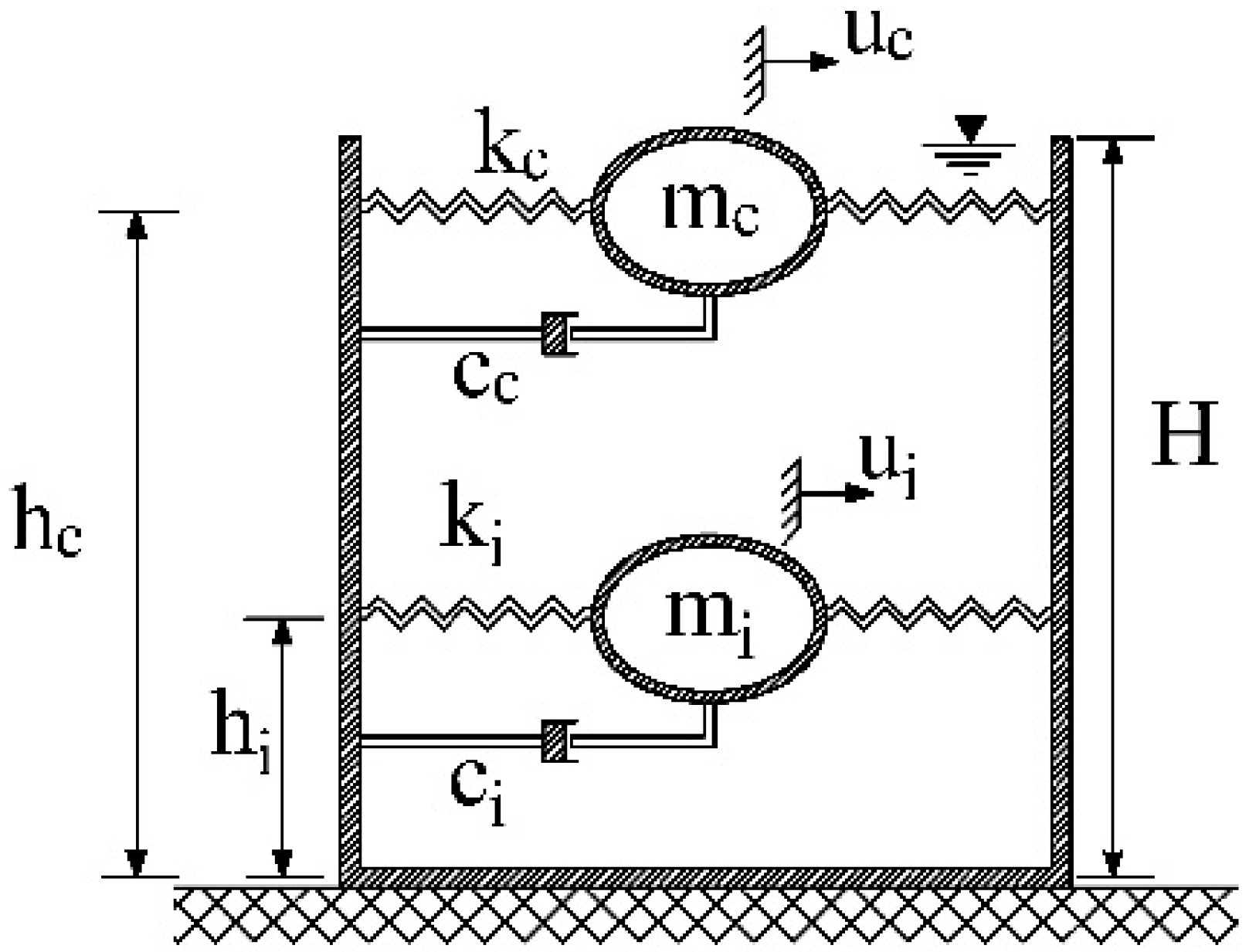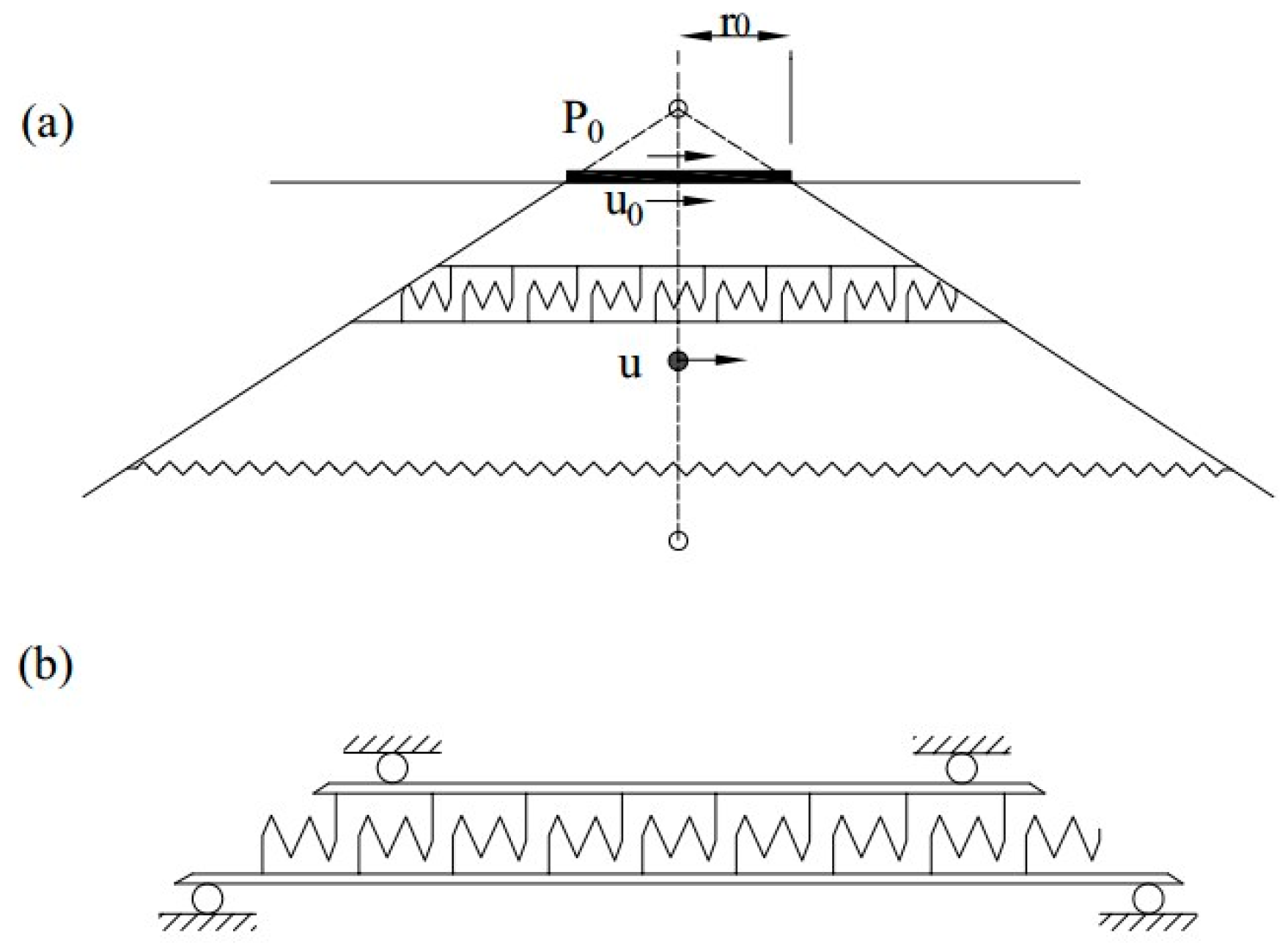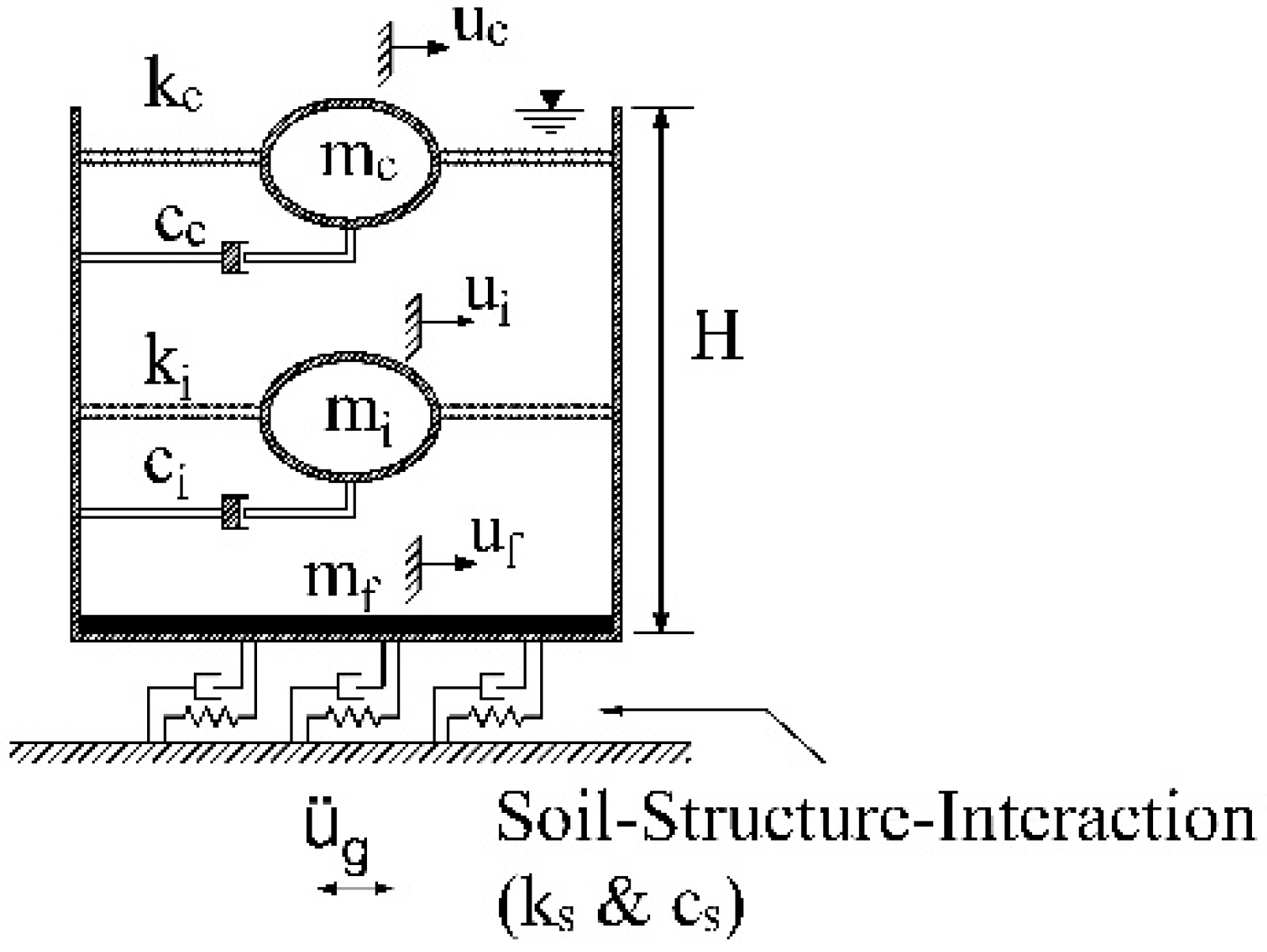1. Introduction
Liquid storage tanks are important structures which have a key role in human lives. The major existing codes, regulations, guidelines, and recommendations—such as API (650, 620), AWWA (D100, D103, D110, D115), Eurocode 8 Part 4 (and Eurocode 3), UNI EN 14015, Covenin, IITK, ACI (350.3, 371.R), NZSEE, AIJ—for the seismic design of tanks are widely used, although, in some cases, the codes were not correctly applied or there are imperfections in the code requirements. These structures have shown poor performance and failure modes during strong earthquakes—such as overturning, buckling, roof damage, sliding, uplift, different settlement, etc., which may also cause liquid leakage and fire after an earthquake—as described, for example, in [
1,
2,
3,
4].
It is clear that, in designing of such structures, all factors that affect seismic responses of these structures should be considered. One of these factors is soil-structure-interaction (SSI). The SSI affects earthquake ground motions, characteristics of structures, and also soil properties. Accordingly, depending on the period of structure, the seismic response of structure could either increase or decrease. Several studies showed that the SSI effect is more important for massive structures such as tall buildings, bridges, and liquid storage tanks which could cause to suspend their performance [
5,
6]. The most popular and relatively accurate model to represent the soil-structure-interaction is the substructure method which considers the soil as coupled springs and dashpots [
7,
8].
Liquid storage tanks behave differently from common structures, such as buildings, bridges, etc., due to fluid-structure-interaction. Housner’s mass-spring model [
7] was the first approximate model to obtain the seismic responses of rigid cylindrical liquid storage tanks. In Housner’s model [
7], the whole liquid is divided into two parts; a portion of liquid which excites independently of the tank wall near the free surface is named as “convective” and the other part of liquid exciting unison with the tank wall is named “impulsive”. By increasing the tank’s geometry (i.e., radius and height), Haroun and Housner [
8] modified the Housner’s model to consider the flexibility of the tank’s wall; in their presented model, the liquid is divided into three portions; convective and impulsive masses which are attached to the tank’s wall through springs and dashpots and the rigid mass which is attached to the tank’s wall rigidly. Malhotra et al. [
9] have proposed a simplified model by considering higher modes of impulsive mass with the first impulsive modal mass and higher mode of convective mass with the first convective modal mass. Bagheri et al. [
10] studied the seismic responses of liquid storage tanks under near-fault ground motions; such earthquake ground motions have long-period components that may affect the long-period sloshing motion of liquid [
10]. The effect of earthquake characteristics on seismic responses of base isolated liquid storage tanks is also studied by Bagheri and Farajian [
11], who showed that the pulse-like earthquake-ground motions could cause excessive displacement in base isolation and, therefore, the impact could occur.
The SSI effect on the seismic response of liquid storage tanks has been studied by several researchers, mostly in the frequency domain. Veletsos and Tang [
12] proposed a method to consider the SSI; they proposed to modify the impulsive mass frequency and damping to consider the SSI effect and their research has shown that the SSI has no special effect on convective mass displacement. Larkin [
13] obtained the responses of steel and concrete liquid storage tanks considering SSI effect, and found that SSI affects the shear force and overturning moment, especially on soft soils. Foundation embedment effects on the behavior of elevated tanks were studied by Livaoglu and Dogangun [
14], who concluded that embedment in soft soil significantly affects the tank roof’s displacement. Livaoglu [
15] shown that decreasing the stiffness of the soil leads to reduction of the base shear and impulsive displacement; on the other hand, sloshing displacement is not considerably affected due to SSI, embedment, and wall flexibility [
15].
In this paper, the effect of SSI on the seismic response of liquid storage tanks is studied under earthquake ground motions in the time domain. Accordingly, after solving the equations of motion in the time domain, the peak responses are obtained and compared with the ones without considering SSI.
4. Results
In this section, the effect of SSI on seismic responses of both broad and slender liquid storage tanks is studied. For example,
Figure 6 depicts the time history of considered responses of two broad and slender tanks mounted on soil type 4 under Chichi-NST-E ground motion in both without SSI and with SSI, respectively.
It is observed that the impulsive mass displacement, normalized overturning moment and normalized base shear are reduced due to SSI effect. SSI causes a shift in the period of the structure; therefore, the responses get reduced. Such reduction will lead to better performance of these structures during earthquake events. On the other hand, the convective mass displacement is slightly affected. This phenomenon is related to the fact that the convective response has a relatively long period and, therefore, the SSI has no special effect on this response.
From
Table 5,
Table 6,
Table 7,
Table 8,
Table 9,
Table 10,
Table 11 and
Table 12, it is observed that the maximum values obtained for the reduction percentage of impulsive mass displacement, normalized overturning moment and normalized base shear are 13.2%, 20.3%, and 20.7% for broad tank under Chichi-NST-E ground motion, and 20%, 19.1%, and 22.5% for slender tank under Chichi-TCU075-W earthquake, when the liquid storage tank rested on soil type 4 (see
Table 11 record no. 1 and
Table 12 record no. 2). From all the data of
Table 5,
Table 6,
Table 7,
Table 8,
Table 9,
Table 10,
Table 11 and
Table 12 (for the six selected earthquake ground motions),
Figure 7 shows the mean reduction percentages of peak responses in broad and slender tank due to SSI effect (where for the calculation of each mean reduction percentage, in those only very few specific cases in which there is amplification and not reduction because of the frequency content of the earthquake and the structure, those reduction percentages are taken as negative). Generally, as the shear velocity of medium soil decreases, the aforementioned responses reduce further. The mean reduction percentages of impulsive mass displacement, normalized overturning moment, and normalized base shear are 7.6%, 8.3%, and 7.9% for broad tank, and 10.4%, 9.9%, and 10.5% for slender tank, when the liquid storage tank rested on soil type 4. According to
Figure 7, the convective mass displacement and also free vertical surface displacement is only slightly reduced. This is due to long period of convective mass. However, for soil type 4, the SSI causes to reduce the convective mass displacement and also free vertical surface displacement, compared to the without SSI condition. This phenomenon is observed in both broad and slender tanks.
5. Conclusions
The seismic behavior of liquid storage tanks, considering the SSI effect, is evaluated in this paper. The substructure method is used to consider the SSI effect, and dynamic stiffness and damping are obtained using the cone method. Two types of tanks rested on four soil types are considered as the case study. Then the peak responses of these tanks, in both with and without considering SSI, under six earthquake excitations are compared. According to obtained responses, the impulsive mass displacement, normalized overturning moment, and normalized base shear are reduced as the SSI effect is considered. However, for relatively stiff soil, this reduction is not considerable but, for soft soil, the SSI effect could shift the fundamental period of impulsive mass and, therefore, the impulsive displacement and other dependent responses reduce.
Since convective mass has a long period, the SSI did not considerably affect its seismic characteristics. Nevertheless, the transition from relatively stiff soil (S1) to softer soil (S4) could cause a shift in the fundamental period of the spectrum and, therefore, the convective displacement is also reduced.
